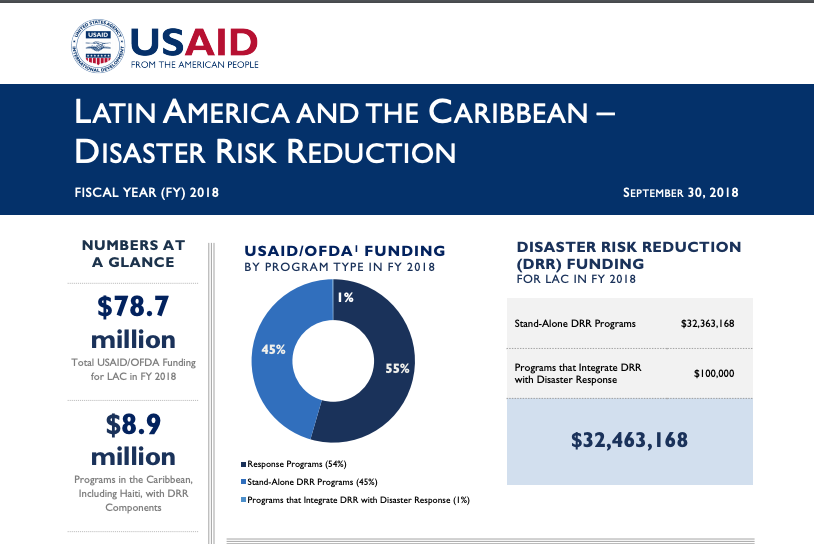US Agency for International Development
Relief Web

OVERVIEW
• Countries in the Latin America and the Caribbean (LAC) region2 experience a range of natural hazards, including droughts, earthquakes, floods, forest fires, hurricanes, landslides, tsunamis, and volcanoes. El Niño and La Niña phenomena occur periodically, exacerbating the impacts of hydrometeorological events in the LAC region. Unplanned urban expansion, environmental and natural resource degradation, and land-use management challenges also increase populations’ vulnerability and exposure to natural hazards.
• USAID/OFDA supports DRR programs in LAC to build resilience and improve emergency preparedness, mitigation, and response capacity at the local, national, and regional levels.
USAID/OFDA focuses on strategic, context-specific programs designed to meet particular risk reduction needs in each country, with capacity building as a consistent theme across DRR activities.
• In FY 2018, USAID/OFDA provided nearly $32.5 million to support DRR initiatives throughout the LAC region. USAID/OFDA staff based in the regional office in Costa Rica and the field office in Haiti engaged directly with community members, national officials, and other stakeholders to prepare for, respond to, and lessen the effects of disasters.
STAND-ALONE DRR PROGRAMS IN LAC
In FY 2018, USAID/OFDA provided nearly $32.4 million for stand-alone DRR initiatives that improved preparedness and aimed to prevent and reduce the worst impacts of disasters. USAID/OFDA provided additional funding for global DRR programs that included activities in the LAC region. At the regional and country levels, USAID/OFDA and implementing partners engaged communities, national and local governments, international and regional organizations, and nongovernmental organizations (NGOs) to develop effective strategies tailored to the needs of at-risk populations. Analysis of existing capacities and social, economic, and environmental trends guided program design, and USAID/OFDA programs addressed underlying causes of recurrent disasters, such as environmental degradation, when possible. The programs reflect USAID/OFDA’s commitment to support capacity development; strengthen linkages among risk identification, monitoring, early warning, and preparatory action; and expand partnerships among stakeholders at local, national, and regional levels.
Categories: DRR and CCA



